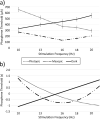Effect of ambient lighting on frequency dependence in transcranial electrical stimulation-induced phosphenes
- PMID: 35545643
- PMCID: PMC9095629
- DOI: 10.1038/s41598-022-11755-y
Effect of ambient lighting on frequency dependence in transcranial electrical stimulation-induced phosphenes
Abstract
Inconsistencies have been found in the relationship between ambient lighting conditions and frequency-dependence in transcranial electric stimulation (tES) induced phosphenes. Using a within-subjects design across lighting condition (dark, mesopic [dim], photopic [bright]) and tES stimulation frequency (10, 13, 16, 18, 20 Hz), this study determined phosphene detection thresholds in 24 subjects receiving tES using an FPz-Cz montage. Minima phosphene thresholds were found at 16 Hz in mesopic, 10 Hz in dark and 20 Hz in photopic lighting conditions, with these thresholds being substantially lower for mesopic than both dark (60% reduction) and photopic (56% reduction), conditions. Further, whereas the phosphene threshold-stimulation frequency relation increased with frequency in the dark and decreased with frequency in the photopic conditions, in the mesopic condition it followed the dark condition relation from 10 to 16 Hz, and photopic condition relation from 16 to 20 Hz. The results clearly demonstrate that ambient lighting is an important factor in the detection of tES-induced phosphenes, and that mesopic conditions are most suitable for obtaining overall phosphene thresholds.
© 2022. The Author(s).
Conflict of interest statement
The authors declare no competing interests.
Figures


References
Publication types
MeSH terms
LinkOut - more resources
Full Text Sources

